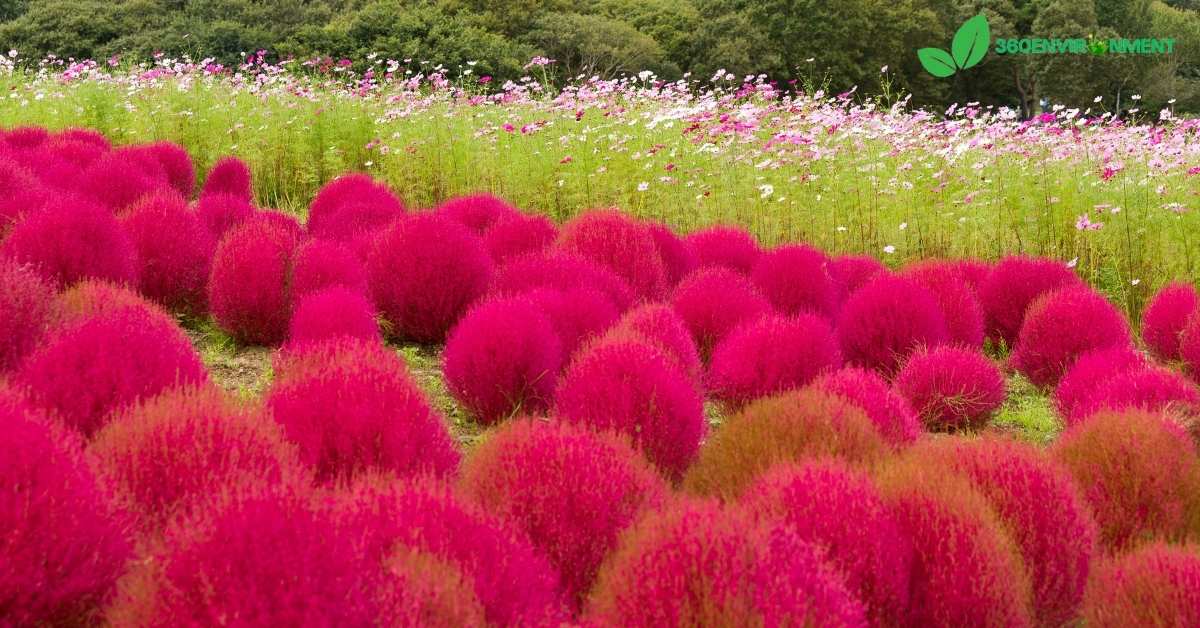The kochia flower (Bassia scoparia), often simply referred to as kochia, is a plant species known for its unique ecological niche, adaptability, and role in both natural and agricultural ecosystems. Originally native to Eurasia, kochia has spread to various parts of the world, becoming particularly well-established in North America, where it has naturalized in many regions. While it’s commonly seen as a weed in agricultural settings, the kochia flower also has important ecological functions in promoting soil health, supporting wildlife, and adapting to challenging environmental conditions.
This article explores the environmental niche of kochia flower, its growth patterns, its ecological contributions, and its interactions with wildlife and humans. We will also examine the plant’s remarkable adaptability to diverse environments, its benefits, and the challenges it presents as an invasive species in some areas. Lastly, we will discuss the role of kochia in restoration ecology, where it is used for soil stabilization and rehabilitation of disturbed lands.
1. Overview of Kochia Flower
The kochia flower, also known as Bassia scoparia or Kochia scoparia, is a herbaceous plant that belongs to the Amaranthaceae family. This fast-growing plant is notable for its adaptability to various environments, particularly arid and semi-arid regions. Its common name, kochia, is derived from the German botanist Wilhelm Daniel Joseph Koch, who first described the plant.
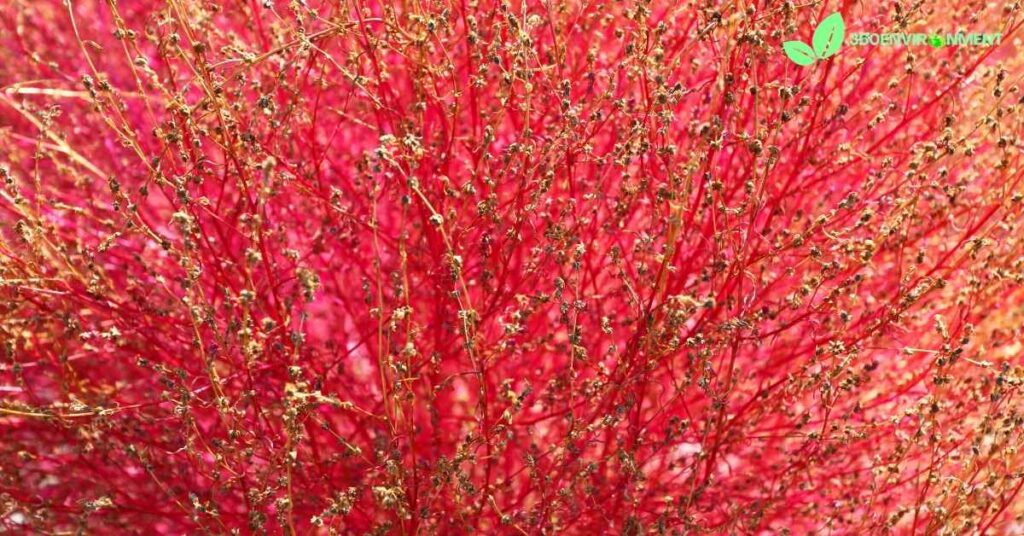
1.1. Physical Characteristics of Kochia Flower
The kochia flower is a highly adaptable and fast-growing species with several distinct physical characteristics that contribute to its ecological success.
- Size and Shape: Kochia can grow up to 1 to 2 meters (3 to 6 feet) tall, depending on environmental conditions. It has a bushy, rounded shape with many branches extending from the main stem, giving it a shrub-like appearance. In its early stages, the plant is soft and green, but as it matures, it becomes more woody, with some species turning reddish or purplish in the fall.
- Flowers and Seeds: The kochia flower itself is relatively small and inconspicuous, typically appearing greenish in color. The flowers are clustered in the axils of leaves, and while they aren’t showy, they are important for seed production. Kochia produces large quantities of seeds, enabling it to spread quickly and establish new populations.
- Leaves: Kochia’s narrow, lance-shaped leaves are covered in fine hairs, which help reduce water loss through evaporation. The leaves are light green and may turn red or purple in autumn, adding to the plant’s aesthetic appeal in landscape settings.
1.2. Growth Habits and Life Cycle
Kochia is a summer annual, meaning it completes its life cycle in one growing season. This rapid growth habit is a key factor in its ability to colonize disturbed or marginal lands quickly.
- Germination and Growth: Kochia seeds typically germinate in early spring when temperatures begin to rise. The plant grows rapidly throughout the summer, often outcompeting native vegetation due to its ability to tolerate drought and poor soil conditions. It thrives in full sunlight and can grow in a wide range of soils, from sandy to clay-heavy substrates.
- Seed Dispersal: Kochia is a prolific seed producer, with each plant capable of generating tens of thousands of seeds. These seeds are spread primarily by wind, though human activity, such as agriculture and construction, can also contribute to its spread. Kochia’s seeds can remain viable in the soil for several years, allowing the plant to re-establish in areas where it has been removed.
2. Habitat and Geographic Distribution of Kochia Flower
The kochia flower is native to Eurasia, particularly in regions of Eastern Europe and Asia, but it has successfully naturalized in many other parts of the world, including North America. Its ability to adapt to various environments has made it both a useful plant in some contexts and a troublesome invasive species in others.
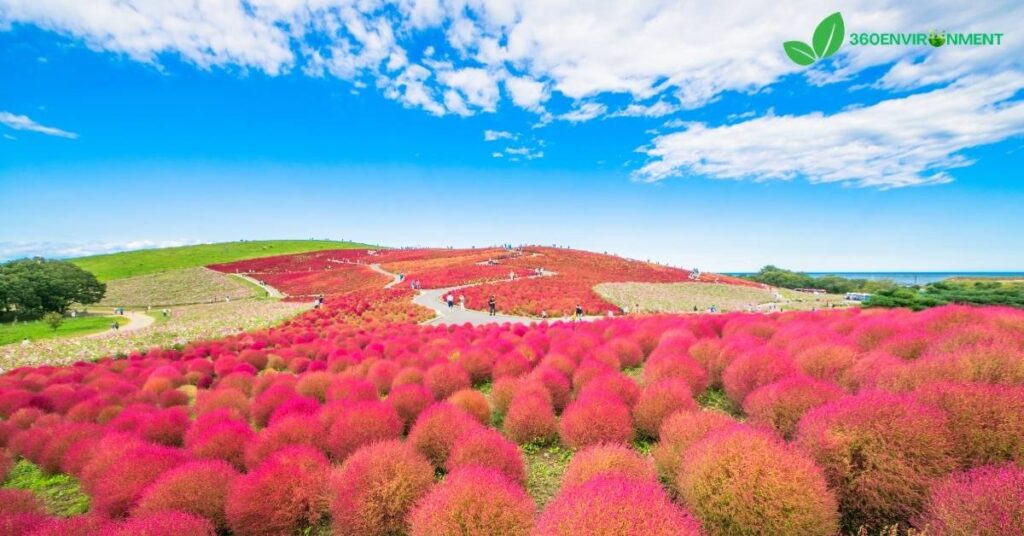
2.1. Native Habitat in Eurasia
In its native range, the kochia flower thrives in dry, arid environments, often growing in grasslands, steppes, and disturbed soils. It is particularly well-suited to the challenging conditions found in these areas, where rainfall is sparse, and temperatures can vary widely.
- Steppes and Grasslands: In the Eurasian steppes, kochia often grows alongside other hardy plants adapted to drought conditions. Its deep taproot allows it to access moisture deep in the soil, enabling it to survive in regions with limited rainfall.
- Disturbed Areas: Kochia is also commonly found in disturbed habitats, such as roadsides, abandoned fields, and areas impacted by human activity. Its ability to quickly colonize open spaces makes it a common sight in areas undergoing ecological change.
2.2. Naturalization and Invasiveness in North America
The kochia flower was introduced to North America in the 19th century, where it quickly became naturalized in the western United States and parts of Canada. While it is valued in some agricultural contexts, its ability to spread rapidly and outcompete native species has led to it being classified as an invasive species in many areas.
- Western United States: In arid and semi-arid regions of the western United States, such as the Great Plains and the Rocky Mountain foothills, kochia thrives in disturbed soils and areas with low rainfall. It is often found growing along roadsides, in fields, and in rangelands, where it can become a dominant species if not managed properly.
- Invasiveness and Ecological Impact: While kochia’s adaptability makes it useful for soil stabilization in some areas, it is considered invasive in others, where it can reduce biodiversity by outcompeting native plant species. This is particularly problematic in rangelands, where kochia can crowd out native grasses that are important for wildlife and livestock.
2.3. Adaptation to Varied Environmental Conditions
One of the reasons the kochia flower is so successful in a variety of environments is its ability to adapt to different soil types, moisture levels, and temperatures. This adaptability makes it a resilient plant capable of thriving in challenging conditions.
- Drought Tolerance: Kochia is highly drought-tolerant, thanks to its deep root system and ability to reduce water loss through its hairy leaves. This makes it a valuable plant in dryland farming systems, where water conservation is critical.
- Soil Adaptability: Kochia can grow in a wide range of soil types, including sandy, loamy, and clay soils. It is also tolerant of saline soils, which makes it an important species for reclamation projects in areas affected by salinity or soil degradation.
3. Ecological Role of Kochia Flower
The kochia flower plays several important roles in the ecosystems it inhabits, particularly in terms of soil health, wildlife interactions, and its use in restoration ecology. While it can be problematic as an invasive species, it also provides certain ecological benefits.
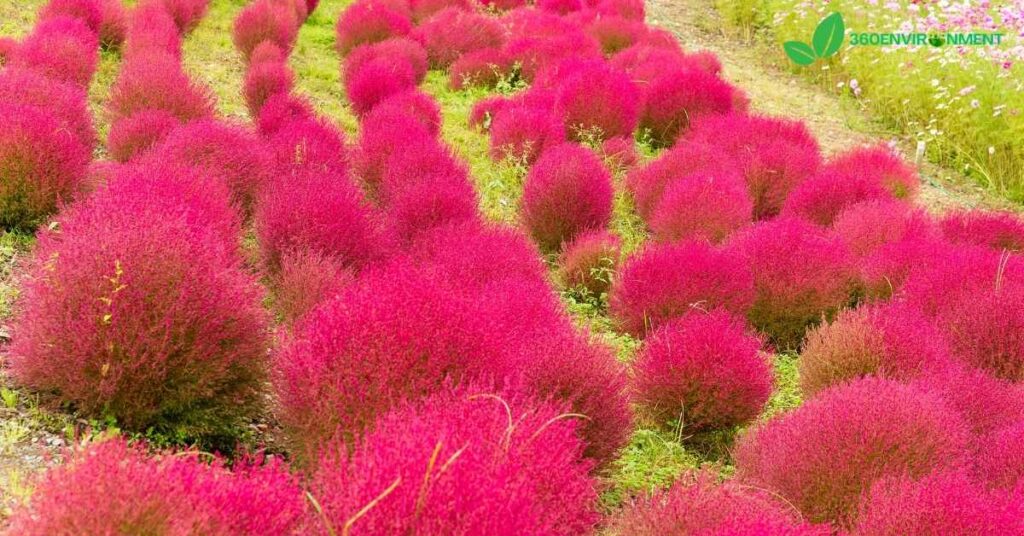
3.1. Soil Stabilization and Erosion Control
Kochia’s extensive root system makes it highly effective at stabilizing soil, particularly in areas prone to erosion. This has made it a valuable species in reclamation projects aimed at restoring disturbed or degraded lands.
- Soil Health: In addition to preventing soil erosion, kochia helps improve soil health by adding organic matter as it decomposes. This organic matter enhances soil structure and fertility, making it easier for other plants to establish and grow.
- Reclamation Projects: Kochia is often used in reclamation projects on degraded lands, such as abandoned mines or areas affected by overgrazing. Its ability to grow in poor soils and its rapid growth rate make it an ideal pioneer species for these projects, where it can help create a more hospitable environment for other plants.
3.2. Interactions with Wildlife
The kochia flower provides food and habitat for a variety of wildlife species, particularly in arid and semi-arid regions where vegetation may be sparse. While it is not a primary food source for most animals, it offers supplemental nutrition and cover.
- Forage for Livestock: In some regions, particularly in the western United States, kochia is used as forage for livestock. While it can be nutritious, it must be grazed carefully, as it can accumulate nitrates and other compounds that are harmful to animals if consumed in large quantities.
- Wildlife Habitat: Kochia provides cover for small mammals and birds, particularly in areas with limited vegetation. It can also serve as a food source for herbivores, although it is generally not a preferred food for most wildlife species.
3.3. Role in Pollination and Seed Dispersal
While the kochia flower is small and not particularly showy, it still plays a role in supporting pollinators and other insects. Its flowers produce nectar and pollen, which attract various pollinators, including bees, flies, and other insects.
- Pollinator Support: Kochia is not a major source of food for pollinators, but it can provide supplemental nectar and pollen, particularly in areas where other flowering plants are scarce.
- Seed Dispersal: Kochia’s prolific seed production ensures that it can spread quickly to new areas. Its seeds are dispersed by wind, and in some cases, by animals that consume the seeds and then excrete them elsewhere.
4. Adaptations and Survival Strategies
Kochia’s success in a wide range of environments can be attributed to its numerous adaptations, which enable it to thrive in challenging conditions. These adaptations include drought tolerance, the ability to grow in poor soils, and a rapid reproductive cycle.
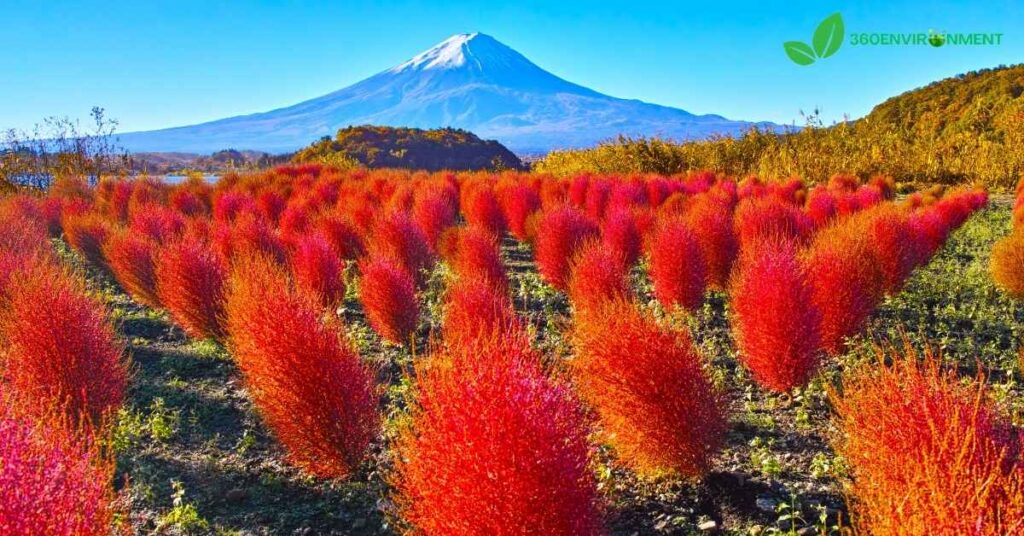
4.1. Drought Tolerance and Water Conservation
One of the key adaptations of the kochia flower is its ability to survive in arid and semi-arid environments, where water is scarce.
- Deep Root System: Kochia’s deep taproot allows it to access water stored deep in the soil, enabling it to survive prolonged periods of drought. This is particularly important in regions with little rainfall, where other plants may struggle to survive.
- Water Conservation Mechanisms: The fine hairs on kochia’s leaves help reduce water loss by creating a microclimate around the leaf surface, reducing the amount of water that evaporates. This adaptation allows kochia to conserve water and thrive in dry conditions.
4.2. Rapid Growth and Reproductive Strategies
Kochia’s ability to grow rapidly and produce large quantities of seeds is another important factor in its ecological success.
- Rapid Growth: Kochia grows quickly, often reaching its full height within a single growing season. This rapid growth allows it to outcompete other plants, particularly in disturbed areas where competition for resources is high.
- Seed Production: Kochia is a prolific seed producer, with each plant capable of producing tens of thousands of seeds. These seeds are dispersed by wind and can remain viable in the soil for several years, allowing kochia to quickly colonize new areas.
4.3. Tolerance to Poor Soils and Salinity
Kochia is highly tolerant of poor soil conditions, including saline soils that are often inhospitable to other plant species. This makes it a valuable plant in areas where soil degradation has occurred.
- Salinity Tolerance: Kochia can grow in soils with high salinity levels, making it an important species for reclamation projects in areas affected by soil salinization. This tolerance allows kochia to grow in areas where other plants may struggle to survive.
- Soil Improvement: In addition to tolerating poor soils, kochia helps improve soil quality by adding organic matter as it decomposes. This organic matter enhances soil structure and fertility, making it easier for other plants to establish.
5. The Role of Kochia in Agriculture and Environmental Management
While the kochia flower is often seen as a weed in agricultural settings, it also has several benefits when managed properly. In addition to its role in soil stabilization and reclamation, kochia can be used as forage for livestock and as a cover crop in some farming systems.
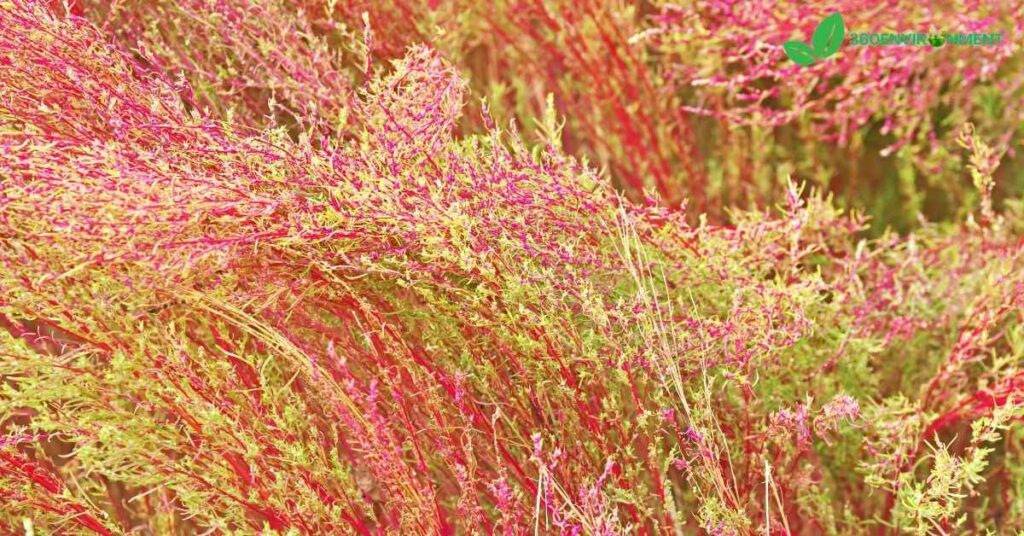
5.1. Forage for Livestock
Kochia is used as a forage crop in some regions, particularly in dryland farming systems where other forage options may be limited. It is high in protein and can provide valuable nutrition for livestock, especially during times of drought.
- Nutritional Value: Kochia is rich in protein and can be a valuable source of nutrition for livestock, particularly during the late summer and fall when other forage crops may be in short supply. However, it must be grazed carefully, as it can accumulate nitrates and other compounds that are harmful to animals if consumed in large quantities.
- Grazing Management: To minimize the risk of nitrate poisoning, kochia should be grazed in rotation with other forage crops, and livestock should be monitored carefully when grazing on kochia.
5.2. Use in Cover Crops and Erosion Control
Kochia is also used as a cover crop in some agricultural systems, particularly in dryland farming where soil erosion is a concern. Its ability to establish quickly and cover the soil helps prevent erosion and improves soil health.
- Cover Crop Benefits: Kochia’s rapid growth and dense foliage make it an effective cover crop, helping to protect soil from wind and water erosion. It also adds organic matter to the soil, improving soil fertility and structure.
- Erosion Control: In addition to its role as a cover crop, kochia is often used in erosion control projects, particularly in areas with sandy or degraded soils. Its extensive root system helps stabilize the soil, preventing erosion and promoting the establishment of other vegetation.
5.3. Challenges as an Invasive Species
While kochia has several ecological benefits, it can also become a problematic invasive species in some regions, particularly in agricultural landscapes.
- Competition with Native Species: In regions where kochia has become invasive, it can outcompete native plant species, reducing biodiversity and altering ecosystem dynamics. This is particularly problematic in rangelands, where kochia can crowd out native grasses that are important for wildlife and livestock.
- Management and Control: Controlling the spread of kochia in areas where it is invasive requires careful management, including the use of herbicides, grazing management, and mechanical removal. In some cases, restoration efforts may be needed to re-establish native vegetation in areas dominated by kochia.
6. Conservation and Restoration Efforts
Despite its reputation as an invasive species in some areas, the kochia flower also plays an important role in conservation and restoration efforts, particularly in arid and degraded landscapes.
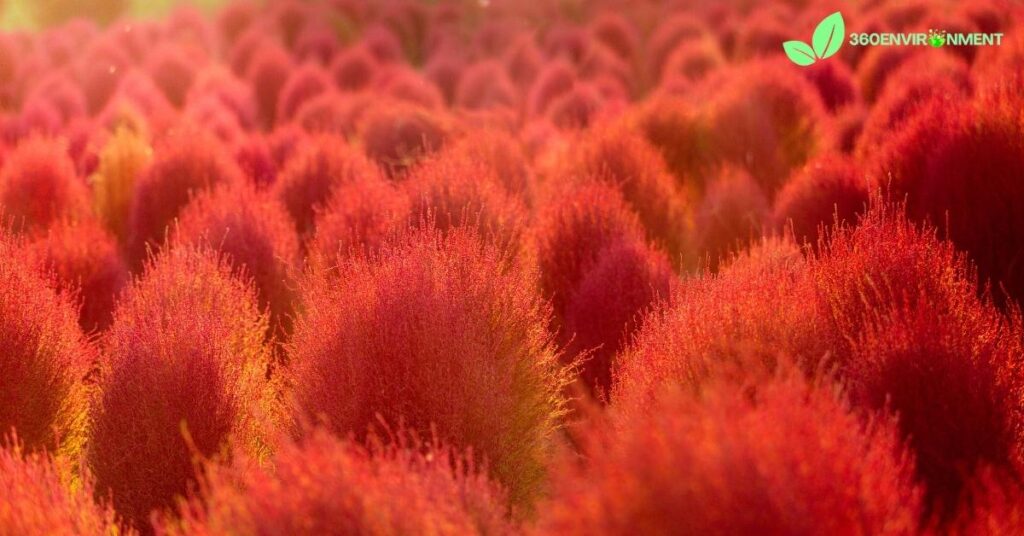
6.1. Role in Habitat Restoration
Kochia is often used in habitat restoration projects, particularly in areas where soil degradation has occurred due to overgrazing, mining, or other human activities.
- Soil Stabilization: Kochia’s deep root system makes it an effective species for stabilizing soil in disturbed areas, preventing erosion and promoting the establishment of other vegetation. This is particularly important in arid and semi-arid regions, where soil erosion can be a major problem.
- Revegetation of Disturbed Lands: In addition to stabilizing soil, kochia helps improve soil health by adding organic matter as it decomposes. This creates a more hospitable environment for other plants, allowing for the revegetation of degraded lands.
6.2. Use in Reclamation Projects
Kochia is also used in reclamation projects aimed at restoring lands affected by mining, construction, or other forms of disturbance. Its ability to grow in poor soils and tolerate salinity makes it an ideal species for these projects.
- Reclamation of Mining Sites: In areas affected by mining, kochia is often used as a pioneer species to help restore soil health and prevent erosion. Its rapid growth and ability to tolerate poor soils make it an important tool in the reclamation of mining sites.
- Soil Salinity Reclamation: In regions where soil salinization has occurred, kochia’s ability to tolerate high levels of salinity makes it a valuable species for reclamation efforts. By stabilizing the soil and improving soil health, kochia helps create a more favorable environment for other plants to establish.
Conclusion: The Ecological Importance of Kochia Flower
The kochia flower is a highly adaptable and ecologically significant plant species, playing important roles in soil stabilization, wildlife support, and habitat restoration. Its ability to thrive in a wide range of environments, from arid grasslands to degraded soils, makes it a valuable tool in conservation and reclamation projects. However, kochia’s invasive potential in some regions highlights the need for careful management to prevent it from outcompeting native vegetation and altering ecosystem dynamics.
By understanding the environmental niche of the kochia flower, we can better appreciate its ecological contributions and develop strategies to manage its impact in both natural and agricultural ecosystems. Whether used as a tool for habitat restoration or managed as an invasive species, kochia remains an important and complex player in the plant world.
Read More: The Bird Bill Flower: Understanding Its Ecology, Adaptations, and Role in the Ecosystem

